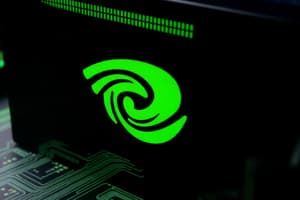Podcast
Questions and Answers
What feature does TensorRT-LLM specifically support for on-device inference?
What feature does TensorRT-LLM specifically support for on-device inference?
- Batch processing only
- Auto-scaling capabilities
- Multi-GPU support
- LoRA adapters and merged checkpoints (correct)
Which library provides a pandas-like API for GPU-accelerated data manipulation?
Which library provides a pandas-like API for GPU-accelerated data manipulation?
- NumPy
- cuDF (correct)
- cuML
- Dask cuDF
Which framework is designed explicitly for advanced natural language processing tasks?
Which framework is designed explicitly for advanced natural language processing tasks?
- CUTLASS
- cuDNN
- spaCy (correct)
- NVIDIA RAPIDS
Which tool allows for parallel computing across multiple GPUs with Dask extensions?
Which tool allows for parallel computing across multiple GPUs with Dask extensions?
What is the primary purpose of NVIDIA RAPIDS?
What is the primary purpose of NVIDIA RAPIDS?
Which NVIDIA tool is known for providing high-performance implementations of graph algorithms?
Which NVIDIA tool is known for providing high-performance implementations of graph algorithms?
Which of the following libraries is primarily focused on providing GPU-accelerated machine learning primitives?
Which of the following libraries is primarily focused on providing GPU-accelerated machine learning primitives?
What type of algorithms does cuML provide?
What type of algorithms does cuML provide?
Which deployment option supports LoRA adapters specifically for cloud inference?
Which deployment option supports LoRA adapters specifically for cloud inference?
What is a key feature of NVIDIA Inference Microservices (NIMs)?
What is a key feature of NVIDIA Inference Microservices (NIMs)?
What is the primary purpose of NVIDIA NeMo?
What is the primary purpose of NVIDIA NeMo?
Which feature does the NVIDIA Triton Inference Server offer?
Which feature does the NVIDIA Triton Inference Server offer?
What is the main function of TensorRT?
What is the main function of TensorRT?
What type of library is NCCL?
What type of library is NCCL?
How does Apache Arrow differ from traditional data formats?
How does Apache Arrow differ from traditional data formats?
What advantage does the use of NVIDIA RAPIDS provide?
What advantage does the use of NVIDIA RAPIDS provide?
What is one of the key features of the NeMo toolkit?
What is one of the key features of the NeMo toolkit?
What characterizes the optimizations provided by TensorRT?
What characterizes the optimizations provided by TensorRT?
Which AI framework is NVIDIA Triton designed to work with?
Which AI framework is NVIDIA Triton designed to work with?
What role does NCCL play in GPU computing?
What role does NCCL play in GPU computing?
What is the primary role of NeMo Curator within the NeMo framework?
What is the primary role of NeMo Curator within the NeMo framework?
Which component of NVIDIA AI Enterprise primarily focuses on providing frameworks and models optimized for GPU infrastructure?
Which component of NVIDIA AI Enterprise primarily focuses on providing frameworks and models optimized for GPU infrastructure?
What is a significant feature of NVIDIA TensorRT-LLM?
What is a significant feature of NVIDIA TensorRT-LLM?
What is the primary use of the NVIDIA Triton Inference Server?
What is the primary use of the NVIDIA Triton Inference Server?
Which function does the NeMo Customizer serve in the NeMo framework?
Which function does the NeMo Customizer serve in the NeMo framework?
How does NVIDIA AI Workbench simplify the generative AI model development process?
How does NVIDIA AI Workbench simplify the generative AI model development process?
What aspect of NVIDIA RAPIDS focuses on accelerating data science workflows?
What aspect of NVIDIA RAPIDS focuses on accelerating data science workflows?
What is a primary advantage of using TRT-LLM for multi-GPU execution?
What is a primary advantage of using TRT-LLM for multi-GPU execution?
How does inflight batching contribute to GPU utilization?
How does inflight batching contribute to GPU utilization?
What significant benefit does NVIDIA AI Inference Manager (AIM) SDK provide?
What significant benefit does NVIDIA AI Inference Manager (AIM) SDK provide?
Which of the following describes a feature of NVIDIA AI Enterprise?
Which of the following describes a feature of NVIDIA AI Enterprise?
What primary function does NeMo Core serve in the NeMo framework?
What primary function does NeMo Core serve in the NeMo framework?
What capability does the NVIDIA RTX AI Toolkit offer to developers?
What capability does the NVIDIA RTX AI Toolkit offer to developers?
Which model quantization technique is considered viable for enhancing performance?
Which model quantization technique is considered viable for enhancing performance?
What is the primary role of Triton Inference Server when running LLMs on Windows?
What is the primary role of Triton Inference Server when running LLMs on Windows?
How do multimodal LLMs, such as NEMO, enhance application capabilities?
How do multimodal LLMs, such as NEMO, enhance application capabilities?
What is a significant feature of DGX Cloud within NVIDIA AI Foundry?
What is a significant feature of DGX Cloud within NVIDIA AI Foundry?
What distinguishes NVIDIA's NVLink technology in GPU architecture?
What distinguishes NVIDIA's NVLink technology in GPU architecture?
In what way do LLM agents leverage plugins?
In what way do LLM agents leverage plugins?
What is the primary function of NGC in NVIDIA's ecosystem?
What is the primary function of NGC in NVIDIA's ecosystem?
Flashcards are hidden until you start studying
Study Notes
NVIDIA AI and Tools
- CUTLASS: A collection of CUDA C++ templates designed for high-performance matrix multiplication.
- RAFT: A suite of GPU-accelerated machine learning primitives.
- cuDNN: A library for GPU-accelerated deep neural network operations.
Deployment and Inference Options
- TensorRT-LLM: Implements LoRA adapters and merged checkpoints for on-device inference.
- llama.cpp: Supports LoRA adapters for on-device inference.
- ONNX Runtime - DML: Enables LoRA adapters for on-device inference.
- vLLM: Supports cloud inference with LoRA adapters and merged checkpoints.
- NVIDIA Inference Microservices (NIMs): Provides cloud inference options with LoRA adapter support.
NVIDIA-Specific Tooling
- spaCy: An open-source Python library for advanced NLP tasks, including tokenization and named entity recognition.
- NumPy: Fundamental library for scientific computing in Python, supporting large, multi-dimensional arrays and mathematical functions.
- NVIDIA RAPIDS: Open-source platform for GPU-accelerated data analytics and machine learning, integrating with popular data science tools.
- cuDF: A GPU DataFrame library that uses Apache Arrow format, offering a pandas-like API for manipulating tabular data.
- Dask cuDF: Extends cuDF for parallel computing across multiple GPUs, handling larger-than-memory datasets.
- cuML: Suite of fast, GPU-accelerated machine learning algorithms with both GPU and CPU execution capabilities.
- cuGraph: Part of NVIDIA RAPIDS, this library provides high-performance graph algorithms for large-scale analytics.
- Apache Arrow: Cross-language development platform defining a standardized columnar memory format for data.
- NVIDIA NeMo: An open-source toolkit for building conversational AI models, supporting speech recognition and text-to-speech tasks.
- NVIDIA Triton: Inference server that simplifies AI model deployments across various frameworks and hardware.
- TensorRT: High-performance inference library optimizing neural networks for NVIDIA GPUs.
- NCCL: Library for inter-GPU communication, implementing collective operations optimized for NVIDIA GPUs.
NVIDIA NeMo Framework
- NeMo: End-to-end enterprise framework for building and deploying generative AI models.
- NeMo Core: Contains foundational elements like the Neural Module Factory for training and inference.
- NeMo Collections: Specialized modules for automatic speech recognition (ASR), natural language processing (NLP), and text-to-speech (TTS).
- NeMo Curator: Tool for preparing high-quality datasets for large-language model (LLM) pretraining.
- NeMo Customizer: Scalable microservice for fine-tuning LLMs to domain-specific needs.
- NeMo Retriever: Low-latency retrieval tool to enhance generative AI applications.
- NeMo Guardrails: Tool to enforce programmable constraints on LLM outputs.
NVIDIA AI Enterprise
- Cloud-native suite including over 50 frameworks and pretrained models, optimized for GPU infrastructures.
- NVIDIA AI Workbench: Manages data, models, and resources for generative AI development.
- NVIDIA Base Command: Tool for managing large-scale AI workloads on multi-node configurations.
- NVIDIA AI Inference Manager (AIM) SDK: Unified interface for deploying AI models across various devices.
- NVIDIA RTX AI Toolkit: Tools and SDKs for customizing and deploying AI models on RTX PCs and cloud environments.
Key Features and Capabilities
- TRT-LLM: Leverages tensor parallelism for efficient multi-GPU execution and supports multiple precisions for better quantization.
- Inflight Batching: Improves GPU utilization, doubles throughput, and lowers energy costs through continuous request processing.
- Model Quantization: Enhances throughput, latency, and scalability, requiring testing for specific use cases.
- Windows Compatibility: Runs LLMs on Windows via Triton Inference Server, ensuring low latency and data privacy.
- Multimodal LLMs: Capable of processing both text and images, enabling new applications, exemplified by NEMO Vision and Language Assistant.
- LLM Agents and Plugins: Allows reasoning, task execution, and enhanced capabilities through plugins.
Glossary of NVIDIA-Specific Tooling
- TRT-LLM: Optimization library for LLM inference.
- TensorRT: Deep learning compiler for NVIDIA GPUs.
- NVLink: High-bandwidth interconnect for GPUs.
- CUDA: Parallel computing platform for GPUs.
- NGC: Hub for GPU-optimized software.
- DGX Cloud: NVIDIA's cloud service for AI development.
- NEMO: Framework for generative AI models.
- Triton Inference Server: Scalable AI model serving software.
- WSL: Windows Subsystem for Linux.
- NVIDIA AI Enterprise: Software suite for AI development and deployment.
Studying That Suits You
Use AI to generate personalized quizzes and flashcards to suit your learning preferences.




